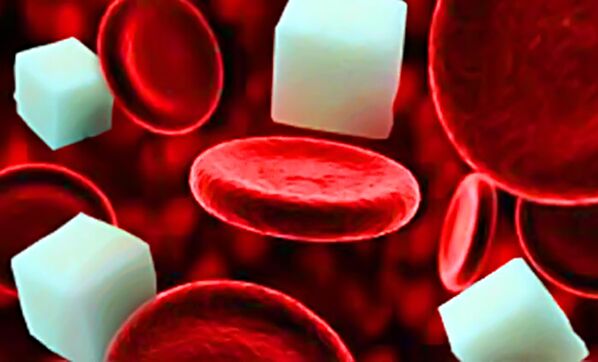Diagnosing diabetes begins with finding the main signs and symptoms. Although there are similarities in the clinical manifestations of the disease, each diabetes has its own characteristics.
Diabetes mellitus was described by the ancient Egyptians about a thousand and a half years ago as an independent pathological unit. The diagnosis was then established by various methods, which are not used today due to incompatibility. For example, Hippocrates told his patients that they had diabetes, their clinic would light up if the urine tasted sweet on testing. In Chinese medicine, to diagnose this insidious disease, insects are used - flies, wasps, which, when there is sugar in the urine, land on the container of urine.
Classify

Diabetes itself is a disease of the endocrine system. Along with it, blood sugar levels are constantly increasing for various reasons. This is usually an insulin deficiency, which can be absolute or relative. This hormone is produced in beta cells located in the tail of the pancreas.
The result of this process is always a violation of the human body's metabolism at all levels, which ultimately leads to serious complications from the cardiovascular and nervous systems to a greater extent, andThe rest of the body's functions are less affected.
To date, there are several types of diseases that have completely different treatment approaches. At the same time, regardless of diabetes, the clinics for the condition are almost the same.
The most common classifications in the literature are:
- At a young age, as in children, absolute insulin deficiency diabetes is most common. It is called the first type.
- Insulin-dependent diabetes occurs more frequently in adulthood and is characterized by relative insulin deficiency. Type 2 diabetes usually occurs in older people, but in some cases it affects younger people as well. It is much more common than the first type, and one of the predisposing factors to the pathology is being overweight.
- There are symptoms. This type of disease can occur against the background of other pathological processes, so it is also called secondary.
- Gestational diabetes occurs during pregnancy. It usually goes away on its own after delivery.
- With malnutrition, such a pathology as diabetes mellitus can also develop.
It should be noted again that the first and second types of pathology are distinguished by the development of absolute and relative insulin deficiency, respectively. Therefore, it is the first type of disease that requires the continuous use of insulin from the outside. And when the pancreas is exhausted, especially in the case of long-standing type 2 diabetes, the same need arises.
The latter type of disease itself can be characterized by an adequate production of insulin, but the body's cells are not sensitive to it for several reasons: the organs responsible for this process can be blocked orTheir number is not enough for effective communication. As a result, the cells develop a sugar deficiency, which signals increased insulin production, which has little effect. As a result, the amount of insulin produced begins to decrease, leading to an increase in blood glucose readings.
The reasons

The basis of the absolute insulin deficiency, which leads to the first type of disease, is an autoimmune process. It is caused by a violation of the immune system, which stimulates the production of its own antibodies directed against the beta cells of the islets of Langerhans. This leads to their destruction.
The main provoking factors that disrupt the immune system with the subsequent production of antibodies are usually various viral infections, the strongest of which can be rubella, chickenpox, mumps. There is a genetic predisposition to the pathology.
It should be borne in mind that a substance such as selenium increases the likelihood of the second type of pathology. But this is not the most important factor in the development of the process. These include the same genetic predisposition and the presence of excess weight. These factors need to be considered in more detail.
- The higher the degree of obesity, the higher the risk of diabetes, and the higher the degree 3, the 10-fold increase. Abdominal obesity, i. e. when fat accumulates in the abdominal area, can be the result of a metabolic disorder, i. e. prediabetes.
- Genetic predisposition shows that the risk of diabetes is increased several times with this pathology in blood relatives. It doesn't matter whether an older or younger relative has the disease. There is sometimes a tendency to think that the disease is transmitted through generations, but this is just a coincidence.
It should be noted that if diabetes is detected, the hospital will develop very slowly and gradually, complicating the untimely diagnosis.
Secondary diabetes mellitus often develops against the background of the following processes:
- Organic pathologies of the pancreas - an inflammatory or cancerous process, trauma, violation of integrity due to resection.
- Other hormonal pathologies - diseases of the thyroid gland, adrenal gland, pituitary gland.
- Toxic effects of drugs and other chemical agents.
- Changes in insulin sensitivity against the background of any pathological process.
- The patient has a genetic disease.
Gestational diabetes and malnourished diabetes are somewhat different because they can be reversed.
What happens in the body?

Due to one or more of the above reasons, a process occurs in the body in which excess sugar in the form of glycogen in muscle tissue and the liver is no longer deposited. Sugar that the body cannot process continues to enter the bloodstream and only a small part is eliminated through the kidneys. This has an extremely negative effect on absolutely all organs and systems of the body.
Since glucose does not enter the cells, they begin to actively break down fats for energy. This leads to the increased formation of nitrogenous residues - ketone bodies, which disturb all metabolic processes.
Clinical picture
The most characteristic symptoms of an undiagnosed disease or with a marked increase in sugar, can be:
- excessive thirst, accompanied by dry mouth;
- increased urination during the day and at night;
- the appearance of general weakness, drowsiness, fatigue and heaviness in the muscles;
- appetite increases significantly;
- itchy skin and genitals;
- the wound surface heals for a very long time;
- In type 1 diabetes, patients lose a lot of weight, and in type 2 diabetes, on the contrary, patients gain rapidly.
Usually, with the development of type 1 diabetes, the clinical symptoms develop at an extremely rapid rate, and the second type of pathology is characterized by a gradual increase in the clinic, sometimes the symptoms. symptoms may be undulating (the normal state alternates with the clinical picture of diabetes).
Complications of the disease

Both types of these pathologies are characterized by the development of complications that often develop in a person in old age. Diabetes also contributes to the earlier development of such conditions.
- Serious diseases of the cardiovascular system: atherosclerosis, ischemic conditions.
- Development of microscopic pathologies of the lower extremities, kidneys, eyes.
- Nervous system damage, manifested in the form of dry skin, severe pain and cramps in the legs, decreased sensitivity to pain.
- Reduced eyesight.
- Damage to the kidneys due to a violation of their function and increased protein excretion.
- Ulcerative defects develop on the feet, which eventually lead to necrotic and purulent processes. The basis for this is the development of neuropathy and vascular disease of the lower extremities.
- The development of infectious complications on the skin - abscesses, fungal infections.
- Due to poor glycemic control, a high or low sugar coma can develop. It has been noted that hypoglycemia (low sugar) is much more difficult to treat than hyperglycemia (high sugar).
Sometimes with type 1 diabetes, the state of health deteriorates, accompanied by general weakness. May be accompanied by abdominal pain to vomiting, with an odor of acetone from the mouth. These changes are explained by the accumulation of ketone bodies, which must be eliminated from the blood as quickly as possible. If this does not happen, a ketoacidotic coma will develop.
It is possible to go into a coma due to improper use of insulin, when too much is taken. To prevent the development of any type of diabetic coma, you should constantly monitor your blood sugar and choose the right dose of insulin.
Diagnose

Patients who have been diagnosed with diabetes are under the control of an endocrinologist. Diagnosis of the disease includes the following tests:
- Analysis of blood glucose profiles.
- Glucose tolerance test.
- Urinalysis for the presence of sugar and acetone, for this there are special test strips.
- Blood test for glycated hemoglobin, in healthy people, it is never above the norm.
- Identify peptide C, reduced in the first type of pathology. In the latter, it may remain within the normal range.
The treatment
In order to follow the course of treatment, the patient needs:
- Follow dietary recommendations. They mean limiting foods that contain fast carbohydrates. Should review the diet, prioritize five meals a day.
- Insulin therapy is indicated for patients with primary type diabetes or secondary insulin-dependent diabetes. It is injected under the skin using a syringe or a special injection pen. Sometimes the patient is fitted with an insulin pump. To date, an artificial pancreas is being developed that can measure sugar levels and inject the right amount of insulin.
- The second type of disease involves the use of sugar-reducing tablets.
- Special physiotherapeutic exercises are indicated, since physical activity normalizes blood sugar and helps fight obesity.
It must be kept in mind that this disease is treated for life. The higher the patient's degree of autonomy, the less likely the patient will develop life-threatening complications and their progression will slow down significantly.


























